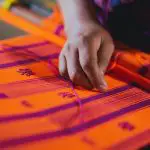Are you wondering if you can screen print on satin fabric? Look no further!
This article will guide you through the basics of screen printing on satin fabric, from choosing the right ink to preparing the fabric.
With our step-by-step guide and helpful tips, you’ll be able to achieve great results in no time.
So, let’s dive in and explore the world of screen printing on satin fabric together!
Table of Contents
The Basics of Screen Printing on Satin Fabric
You can easily screen print on satin fabric by following a few basic steps.
Screen printing is one of the most popular printing techniques used to create beautiful designs on various fabrics, including satin.
To begin, gather all the necessary materials: satin fabric, a screen, ink, a squeegee, and a design stencil.
Start by placing the fabric on a flat surface and securing it in place.
Next, position the screen on top of the fabric, ensuring that the design stencil aligns correctly.
Apply a generous amount of ink onto the screen and use the squeegee to evenly distribute the ink over the stencil.
Make sure to apply enough pressure to transfer the design onto the fabric.
Once the printing is complete, carefully lift the screen off the fabric and allow the ink to dry.
Troubleshooting common issues include ensuring that the fabric is stretched tightly to avoid smudging and using the right amount of ink to prevent bleeding.
Choosing the Right Screen Printing Ink for Satin Fabric
Selecting the appropriate ink for satin fabric requires careful consideration. When screen printing on satin fabric, you may encounter some common challenges that can affect the quality of your prints. However, there are alternative printing methods that can help overcome these challenges.
Here are four important factors to consider when choosing the right ink for satin fabric:
-
Fabric compatibility: Satin fabric is delicate and smooth, so it’s crucial to choose an ink that is specially formulated for this type of fabric. Look for inks that are designed to adhere well to satin and provide excellent color vibrancy.
-
Ink opacity: Satin fabric is often lightweight and semi-transparent, which can affect the visibility of your prints. Opt for highly opaque inks that offer good coverage and prevent the color from appearing faded or washed out.
-
Ink flexibility: Satin fabric has a tendency to stretch and drape, so it’s important to select an ink that can withstand these movements without cracking or peeling. Look for inks that offer good flexibility and elasticity to ensure longevity and durability of your prints.
-
Alternative printing methods: If screen printing proves to be challenging on satin fabric, you can explore alternative techniques such as heat transfer or digital printing. These methods can provide more flexibility and accuracy, ensuring high-quality prints on satin fabric.
Preparing Satin Fabric for Screen Printing
Before beginning the screen printing process, it’s important to properly prepare the satin fabric. This ensures that the ink adheres well and produces a vibrant and long-lasting print. One of the best practices for preparing satin fabric for dyeing is to wash it before printing. Washing removes any dirt, oils, or sizing agents that may be present on the fabric, allowing the ink to penetrate the fibers more effectively.
To wash satin fabric, follow these guidelines:
| 1. | Use a gentle detergent | Choose a mild detergent specifically designed for delicate fabrics like satin. Avoid using bleach or harsh chemicals, as they can damage the fabric. |
| 2. | Hand wash or use the delicate cycle | Satin is a delicate fabric, so it’s best to hand wash it or use the delicate cycle on your washing machine. |
| 3. | Air dry or tumble dry on low | After washing, let the fabric air dry or tumble dry on a low heat setting. Avoid using high heat, as it can cause the fabric to shrink or wrinkle. |
Step-by-Step Guide to Screen Printing on Satin Fabric
One of the key steps in the screen printing process on satin fabric is properly aligning the design on the screen with the fabric. This ensures that the print comes out clean and precise. To help you achieve the best results, here are four important things to keep in mind:
-
Use registration marks: These marks are essential for aligning the design on the screen with the fabric. They act as reference points and ensure that the design is positioned correctly.
-
Test print on a scrap fabric: Before printing on the actual satin fabric, it’s crucial to do a test print on a scrap piece. This allows you to check the registration, color intensity, and overall print quality before committing to the final fabric.
-
Use the right ink: Satin fabric requires a specialized ink that adheres well to its smooth surface. Make sure to use ink specifically designed for satin fabric to achieve the best results.
-
Avoid excessive pressure: Applying too much pressure during the printing process can result in smudging or bleeding of the design. Use a light and even pressure to ensure a clean and crisp print.
Exploring alternative printing techniques for satin fabric can also be a great way to achieve unique and interesting designs. Some alternatives to screen printing include heat transfer, sublimation, and digital printing. Each technique offers its own advantages and can produce stunning results on satin fabric.
Tips and Tricks for Achieving Great Results in Screen Printing on Satin Fabric
To achieve great results in screen printing on satin fabric, remember to properly align the design on the screen with the fabric using registration marks. This step is crucial to ensure that your design appears straight and centered on the fabric.
Common mistakes in this process include misalignment, which can result in a crooked or off-center design. Troubleshooting misalignment issues can be done by double-checking the registration marks on both the screen and the fabric before starting the printing process.
Additionally, make sure that the fabric is stretched taut and secured properly on the printing surface to prevent any movement during printing.
Another common mistake to avoid is using too much or too little pressure when applying the ink onto the fabric. This can lead to smudging or incomplete coverage of the design. Troubleshooting this issue involves adjusting the pressure on the squeegee and performing test prints to achieve the desired ink coverage.
Conclusion
In conclusion, screen printing on satin fabric is a versatile and achievable process. By following the right steps, such as choosing the appropriate ink and properly preparing the fabric, you can achieve great results.
It is important to pay attention to details and use the right techniques to ensure a smooth and successful printing process. With practice and the right tools, you can create beautiful and professional-looking prints on satin fabric.
So go ahead, try it out and see the amazing results for yourself!
- How Does Ring Spun Cotton Affect Garment Fit and Shape Retention? - August 13, 2024
- What Are the Challenges in Producing Ring Spun Cotton? - August 13, 2024
- Is Ring Spun Cotton Suitable for Plus-Size Clothing? - August 13, 2024



